TradingView’s Technical Ratings Indicator: A Comprehensive Guide
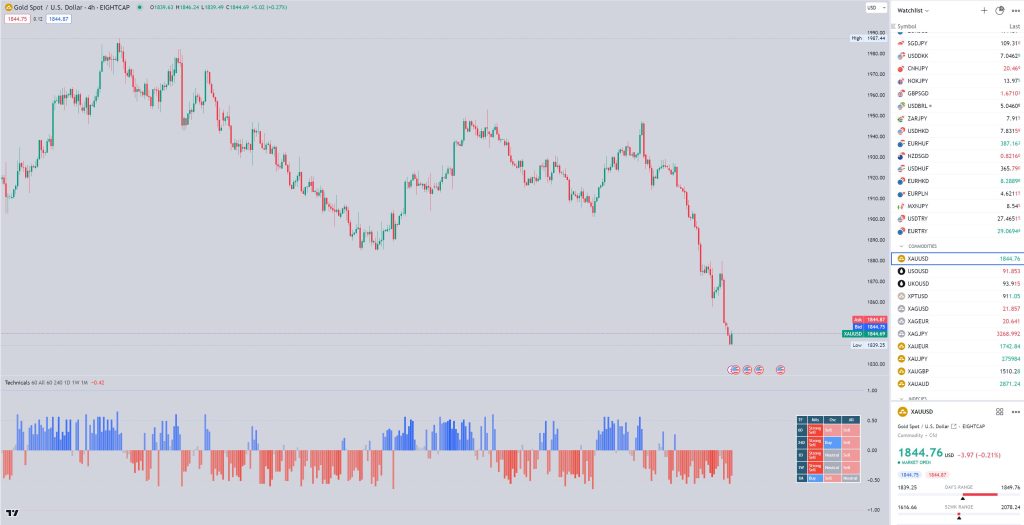
One of the many tools available on the Trading View platform is the Technical Ratings indicator, which provides valuable insights into a particular asset’s technical strength or weakness. It also appears as one of the top 5 most used indicators there and this is why, In this article, we will delve into the details of the Technical Ratings indicator, its components, and how traders can effectively use it to enhance their decision-making process.
Definition of the Technical Ratings Indicator
The Technical Ratings indicator on TradingView is a comprehensive tool designed to offer traders valuable insights into an asset’s technical performance. It serves as a quantitative assessment mechanism that aids in decision-making by simplifying complex technical analyses. While the exact workings of the indicator are proprietary, we can break down its fundamental characteristics for a more detailed understanding:
Data Integration and Analysis
The Technical Ratings indicator integrates a diverse set of technical data points, encompassing moving averages, oscillators, trend strength metrics, momentum indicators, volatility measures, and potentially other relevant indicators. These components form the foundation for the indicator’s assessments.
The indications shown by the indicator are based on the ratings calculated for the various indicators included in it.
The overall rating of the indicator includes two large groups of indicators:
The first consists of SMAs and EMAs with different lengths (MA lengths are 10, 20, 30, 50, 100 and 200), the Ichimoku Cloud indicator (9, 26, 52), the VWMA (20), and the HullMA (9).
The second one is calculated using a number of oscillators including:
RSI (14), Stochastic (14, 3, 3), CCI (20), ADX (14, 14), AO, Momentum (10), MACD (12, 26, 9), Stochastic RSI (3, 3, 14, 14), Williams %R (14), Bulls and Bears Power and UO (7,14,28).
Each group’s rating is calculated separately, so you can select the group in the indicator settings and its respective rating calculation will be displayed on the chart.
Let’s look into the calculations in detail:
These are the criteria used to determine the rating of the individual indicators used. Note that changes from the last bar are used to determine falling or rising states:
All Moving Averages
- Buy — MA value < price
- Sell — MA value > price
- Neutral — MA value = price
Ichimoku Cloud
- Buy — base line < price and conversion line crosses price from below and lead line 1 > price and lead line 1 > lead line 2
- Sell — base line > price and conversion line crosses price from above and lead line 1 < price and lead line 1 < lead line 2
- Neutral — neither Buy nor Sell
Relative Strength Index
- Buy — indicator < 30 and rising
- Sell — indicator > 70 and falling
- Neutral — neither Buy nor Sell
Stochastic
- Buy — main line < 20 and main line crosses over the signal line
- Sell — main line > 80 and main line crosses under the signal line
- Neutral — neither Buy nor Sell
Commodity Channel Index
- Buy — indicator < -100 and rising
- Sell — indicator > 100 and falling
- Neutral — neither Buy nor Sell
Average Directional Index
- Buy — indicator > 20 and +DI line crosses over -DI line
- Sell — indicator > 20 and +DI line crosses under -DI line
- Neutral — neither Buy nor Sell
Awesome Oscillator
- Buy — saucer and values are greater than 0, or cross over the zero line
- Sell — saucer and values are lower than 0, or cross under the zero line
- Neutral — neither Buy nor Sell
Momentum
- Buy — indicator values are rising
- Sell — indicator values are falling
- Neutral — neither Buy nor Sell
MACD
- Buy — main line values > signal line values
- Sell — main line values < signal line values
- Neutral — neither Buy nor Sell
Stochastic RSI
- Buy — downtrend and K and D lines < 20 and K line crosses over D line
- Sell — uptrend and K and D lines > 80 and K line crosses under D line
- Neutral — neither Buy nor Sell
Williams Percent Range
- Buy — indicator < lower band and rising
- Sell — indicator > upper band and falling
- Neutral — neither Buy nor Sell
Bulls and Bears Power
- Buy — uptrend and BearPower < zero and BearPower is rising
- Sell — downtrend and BullPower > zero and BullPower is falling
- Neutral — neither Buy nor Sell
Ultimate Oscillator
- Buy — UO > 70
- Sell — UO < 30
- Neutral — neither Buy nor Sell
Recommendations for the group or overall ratings are based on this numerical rating value and determined according to the following criteria:
- [-1.0 ≥ value < -0.5] — Strong Sell
- [-0.5 ≥ value < -0.1] — Sell
- [-0.1 ≥ value ≤ 0.1] — Neutral
- [0.1 > value ≤ 0.5] — Buy
- [0.5 > value ≤ 1.0] — Strong Buy
Algorithmic Processing and Qualitative Assessment
The indicator employs a sophisticated algorithm to process the collected data. This algorithm is crafted to weigh and analyze each component based on its historical effectiveness and relevance in technical analysis. The specific details of the algorithm are typically not disclosed to maintain the integrity and effectiveness of the indicator.
The output of the Technical Ratings indicator is qualitative in nature, providing simplified recommendations in the form of “Buy,” “Sell,” or “Neutral” signals. These indications are designed to offer traders clear and actionable insights without the need for detailed technical analysis.
Dynamic Adaptability and User-Friendly Interface
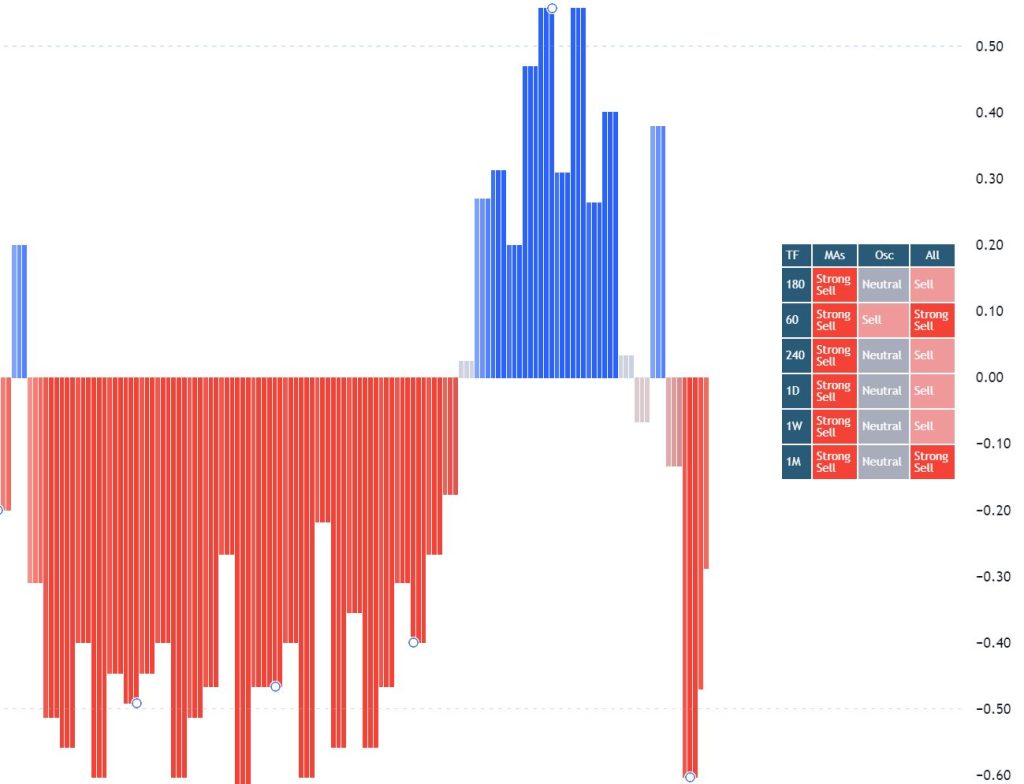
The indicator is adaptable to changing market conditions. This means that the weighting assigned to different technical components may be adjusted over time to ensure that the indicator remains relevant and effective in various market environments.
TradingView presents the Technical Ratings indicator in a user-friendly format, often through visual cues like arrows, colors, or labels on the chart. This allows traders to quickly grasp the recommended action for a given time frame.
How the Technical Ratings Indicator Works in Detail
As we hinted above, the Technical Ratings indicator on TradingView operates through a sophisticated algorithm that evaluates various technical components to provide Buy, Sell, or Neutral signals. While the specific details of the algorithm are proprietary, we can explore the general principles that likely influence its decision-making process:
Moving Averages Analysis:
- The indicator likely considers multiple moving averages and their interactions. For instance, it may assess the relationship between short-term moving averages (e.g., 10-day) and long-term moving averages (e.g., 50-day). Crossovers, such as the Golden Cross (short-term moving average crossing above the long-term) or the Death Cross (short-term moving average crossing below the long-term), could significantly influence the indicator’s signal. These events are pivotal as they can indicate potential shifts in market sentiment and trend direction.
Oscillator Indicators:
- Oscillators, like the Relative Strength Index (RSI) and Stochastic Oscillator, are likely instrumental in determining overbought and oversold conditions. The RSI, for example, measures the speed and change of price movements, producing a numerical value between 0 and 100. A high RSI value (above 70) typically signifies an overbought condition, potentially leading to a Sell signal. Conversely, a low RSI value (below 30) may indicate an oversold condition, possibly prompting a Buy signal.
Assessment of Trend Strength:
- The Technical Ratings algorithm probably incorporates indicators like the Average Directional Index (ADX) to gauge the strength of the current trend. ADX values above 25 are indicative of a robust trend, while values below 20 suggest a weaker or ranging market. This information is essential for trend-following strategies, as it helps traders discern whether a trend is well-established or may be losing momentum.
Momentum Indicator Consideration:
- Momentum indicators, such as the Moving Average Convergence Divergence (MACD), are likely factored in to identify shifts in momentum. The MACD is calculated by subtracting the 26-period Exponential Moving Average (EMA) from the 12-period EMA. Additionally, a 9-period Signal Line is plotted. Crossovers and divergences in the MACD can be critical in influencing the indicator’s decision to suggest a Buy or Sell.
Volatility Assessment:
- The indicator probably incorporates measures of market volatility, such as the Average True Range (ATR). This indicator quantifies market volatility by measuring the average range between high and low prices over a specified period. High ATR values suggest higher volatility, which may lead to a Neutral or Sell signal. Conversely, low ATR values indicate lower volatility, potentially prompting a Buy signal.
Inclusion of Other Technical Indicators:
- Depending on the specific configuration of the platform, the Technical Ratings algorithm may also factor in other technical indicators like Bollinger Bands, Moving Average Envelopes, and various trend-following or reversal indicators. These additional indicators provide further depth and context to the technical analysis.
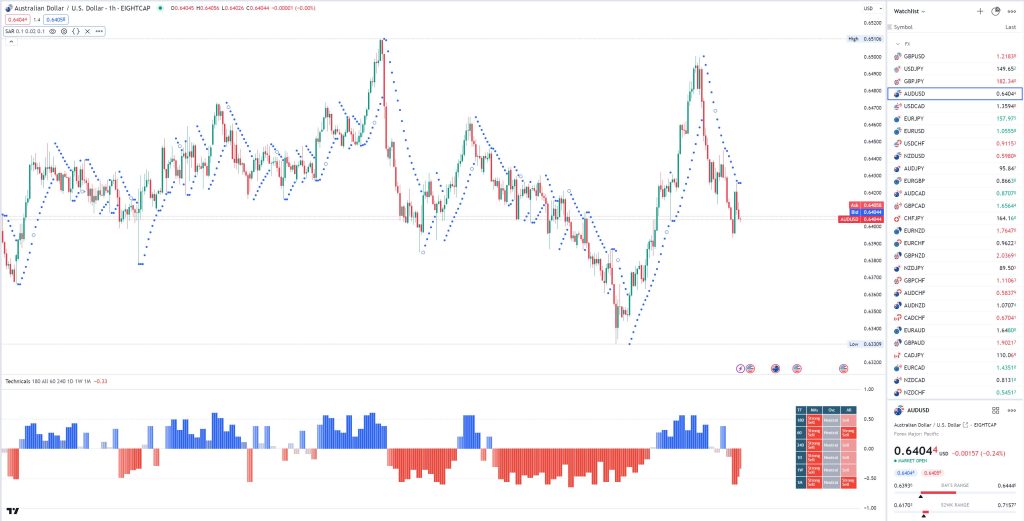
Weighting and Aggregation:
- Each of these factors is likely assigned a weight based on its historical effectiveness and relevance. The algorithm then aggregates the information to arrive at an overall conclusion for the Buy, Sell, or Neutral signal.
Interpreting Technical Ratings
When using TradingView’s Technical Ratings indicator, it’s crucial to understand its qualitative nature. The indicator offers simplified recommendations based on technical analysis, presenting signals of “Buy,” “Sell,” or “Neutral” for a selected time frame. These indications are derived from a composite analysis of various technical components, aiming to assist traders in making informed decisions.
How to Interpret:
- Buy: Indicates a suggestion to consider a long position in the asset.
- Sell: Suggests considering a short position in the asset.
- Neutral: Suggests a holding or wait-and-see approach.
Contextual Considerations
It’s crucial to interpret Technical Ratings within the broader context of the market environment. Factors like prevailing economic conditions, geopolitical events, and company-specific news can significantly impact an asset’s performance.
Historical Comparisons
Comparing current Technical Ratings with historical data can offer valuable insights. For instance, if the current rating is higher than previous periods, it may indicate strengthening technical conditions. Conversely, a lower rating might suggest increasing weakness.
Confirmation and Divergence
Traders often use Technical Ratings in conjunction with other indicators. A confirmation occurs when signals from different indicators align, providing a stronger basis for a trade. Conversely, a divergence, where Technical Ratings conflict with other indicators, may indicate a need for caution and further analysis.
Incorporating Technical Ratings into Trading Strategies
The Technical Ratings indicator on TradingView serves as a valuable tool that can be seamlessly integrated into various trading strategies. Here’s an in-depth look at how traders can leverage this indicator to enhance their decision-making process:
1. Confirmation and Validation of Signals
- Confirmation: When the Technical Ratings align with signals from other indicators or trading strategies, it can provide added confidence in a trade. For instance, if a Moving Average crossover strategy suggests a Buy signal and the Technical Rating aligns with this, it can serve as a reinforcing factor for the trade.
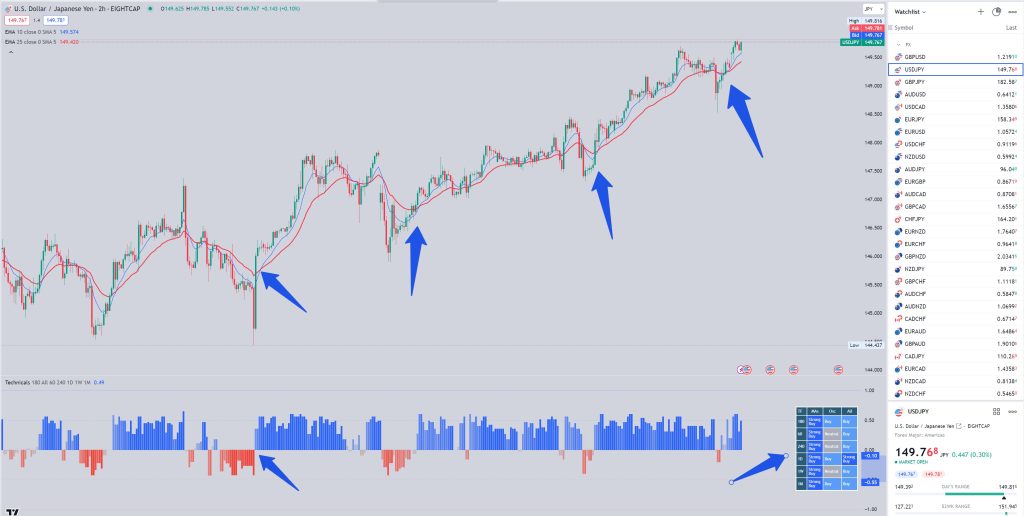
- Validation: The Technical Ratings can act as a validation mechanism for potential trade setups. For example, if a trader identifies a potential trend reversal using a candlestick pattern, they can look to the Technical Ratings to see if it supports or contradicts this assessment.
3. Risk Management Strategies
- Setting Stop-Loss Levels: Traders can use the Technical Ratings to inform their stop-loss placement. For example, if the Technical Rating suggests a strong Buy signal, a trader may opt for a tighter stop-loss to limit potential losses. Conversely, if the rating indicates a weaker signal, a wider stop-loss might be considered to account for potential market volatility.
- Trailing Stops: For traders employing a trend-following strategy, the Technical Ratings can be used to determine when to adjust trailing stops. If the rating remains consistently strong, it may signal an opportunity to tighten the trailing stop to lock in profits. Conversely, if the rating weakens, it may suggest a need to loosen the trailing stop to allow for potential market fluctuations.
4. Position Sizing and Allocation
- The Technical Ratings can play a role in determining position sizes. A higher rating may warrant considering a larger position, indicating higher confidence in the trade. Conversely, a lower rating might suggest considering a smaller position size to mitigate potential risks associated with a weaker technical outlook.
5. Trade Entry and Exit Points
- Entry Points: Traders can use the Technical Ratings as a guide for when to enter a trade. For instance, a strong Buy signal may prompt a trader to initiate a long position, while a strong Sell signal could lead to a short position.
- Exit Points: The Technical Ratings can also influence decisions about when to exit a trade. If the rating weakens significantly after a trade has been initiated, it may signal a potential exit point. Similarly, if the rating strengthens further, it may suggest an opportunity to hold the position for potentially higher gains.
Customizing and Adding the Indicator to Your Eightcap TradingView Account
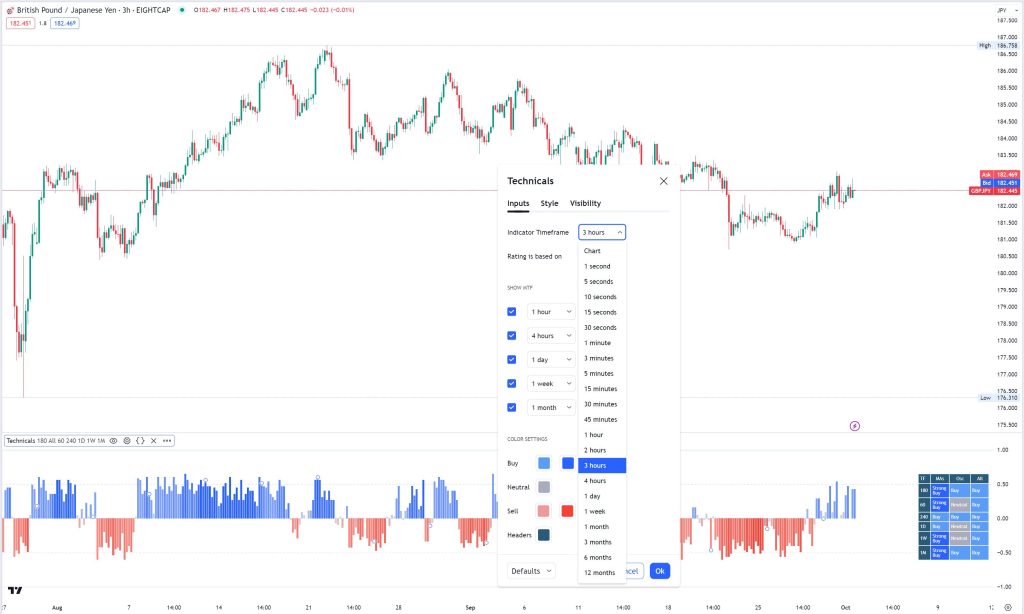
One of the remarkable features of the Technical Ratings indicator is its flexibility and customization options. Traders can tailor the indicator to align with their specific trading preferences and strategies. Through your Eightcap TradingView account, accessing and adding this powerful tool is a straightforward process. Simply Log in to your Eightcap Trading Account on the TradingView platform, select the asset, navigate to the indicators menu search for “Technical Ratings,” and select it to integrate into your charts. From there, you can fine-tune the settings to suit your trading style. This seamless integration empowers traders with the ability to leverage the Technical Ratings indicator directly within their Eightcap TradingView account, enhancing their analytical capabilities and decision-making process.
And one more reminder that it’s important to remember that no single indicator guarantees success in the dynamic world of financial markets. A holistic approach that combines various forms of analysis, risk management, and continuous adaptation is important. Additionally, maintaining discipline and adhering to risk management principles remains paramount.
* The information provided here has been prepared by Eightcap’s team of analysts. All expressions of opinion are subject to change without notice. Any opinions made may be personal to the author and do not reflect the opinions of Eightcap.
In addition to the disclaimer on our website, the material on this page does not contain a record of our trading prices, or represent an offer or solicitation for a transaction in any financial instrument. Eightcap accepts no responsibility for any use that may be made of these comments and for any consequences that result. No representation or warranty is given as to the accuracy or completeness of this information. Consequently, any person acting on it does so entirely at their own risk. Any research provided does not have regard to the specific investment objectives, financial situation and needs of any specific person who may receive it. It has not been prepared in accordance with legal requirements designed to promote the independence of investment research and as such is considered to be a marketing communication.
Please note that past performance is not a guarantee or prediction of future performance. This communication must not be reproduced or further distributed without prior permission.


